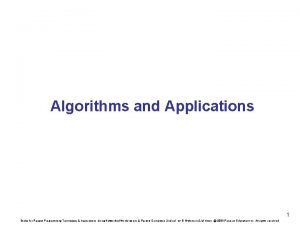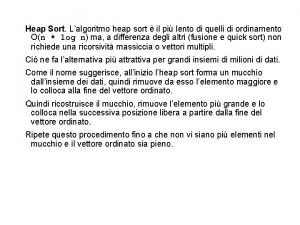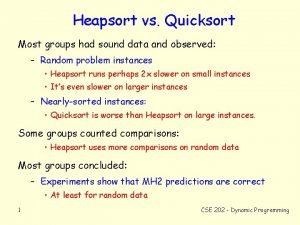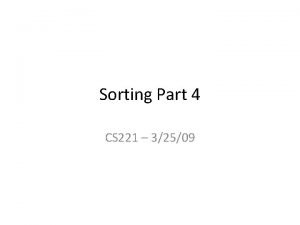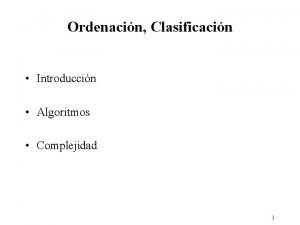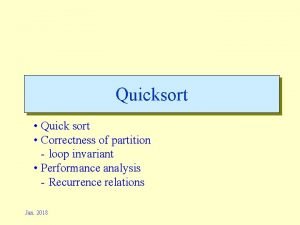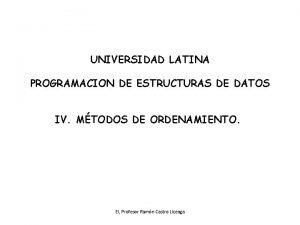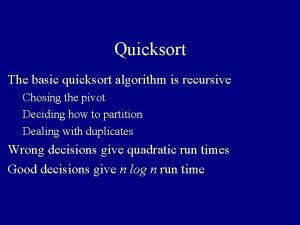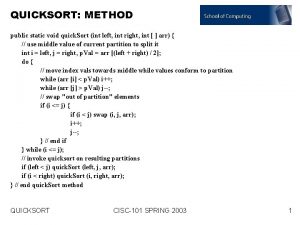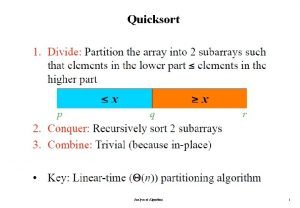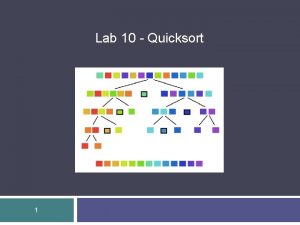1 QuickSort To understand quicksort lets look at
























- Slides: 24

1

Quick-Sort • To understand quick-sort, let’s look at a high-level description of the algorithm 1) Divide : If the sequence S has 2 or more elements, select an element x from S to be your pivot. Any arbitrary element, like the last, will do. Remove all the elements of S and divide them into 3 sequences: L, holds S’s elements less than x E, holds S’s elements equal to x G, holds S’s elements greater than x 2) Recurse: Recursively sort L and G 3) Conquer: Finally, to put elements back into S in order, first inserts the elements of L, then those of E, and those of G. Here are some pretty diagrams. . 2

Idea of Quick Sort 1) Select: pick an element 2) Divide: rearrange elements so that x goes to its final position E 3) Recurse and Conquer: recursively sort 3

Quick-Sort Tree 4

Quick-Sort Tree 5

Quick-Sort Tree 6

Quick-Sort Tree 7

Quick-Sort Tree 8

Quick-Sort Tree 9

Quick-Sort Tree 10

Quick-Sort Tree 11

Quick-Sort Tree 12

Quick-Sort Tree 13

Quick-Sort Tree 14

Quick-Sort Tree Skipping. . . 15

. . . Finally 16

In-Place Quick-Sort Divide step: l scans the sequence from the left, and r from the right. A swap is performed when l is at an element larger than the pivot and r is at one smaller than the pivot. 17

In Place Quick Sort (contd. ) A final swap with the pivot completes the divide step 18

In Place Quick Sort code public class Array. Quick. Sort implements Sort. Object { public void sort(Sequence S, Comparator c){ quicksort(S, C, 0, S. size()-1); }private void quicksort (Sequence S, Comparator c, int left. Bound, int right. Bound) {// left and rightmost ranks of sorting range if (S. size() < 2) return; //a sequence with 0 or 1 elements // is already sorted if (left. Bound >= right. Bound) return; //terminate recursion // pick the pivot as the current last element in range Object pivot = S. at. Rank(right. Bound). element(); // indices used to scan the sorting range int left. Index = left. Bound; // will scan rightward int right. Index = right. Bound - 1; //will scan leftward 19

In Place Quick Sort code (contd. ) // outer loop while (left. Index <= right. Index) { //scan rightward until an element larger than //the pivot is found or the indices cross while ((left. Index <= right. Index) &&(c. is. Less. Than. Or. Equal. To (S. at. Rank(left. Index). element(), pivot)) left. Index++; //scan leftward until an element smaller than //the pivot is found or the indices cross while (right. Index >= left. Index) &&(c. is. Greater. Than. Or. Equal. To (S. at. Rank(right. Index). element(), pivot)) right. Index--; //if an element larger than the pivot and an //element smaller than the pivot have been //found, swap them if (left. Index < right. Index) S. swap(S. at. Rank(left. Index), S. at. Rank(right. Index)); } // the outer loop continues until // the indices cross. End of outer loop. 20

In Place Quick Sort code (contd. ) //put the pivot in its place by swapping it //with the element at left. Index S. swap(S. at. Rank(left. Index), S. at. Rank(right. Bound)); // the pivot is now at left. Index, so recur // on both sides quicksort (S, c, left. Bound, left. Index-1); quick. Sort (S, c, left. Index+1, right. Bound); } // end quicksort method } // end Array. Quick. Sort class 21

Analysis of Running Time • Consider a quick-sort tree T: – Let si(n) denote the sum of the input sizes of the nodes at depth i in T. • We know that s 0(n) = n since the root of T is associated with the entire input set. • Also, s 1(n) = n-1 since the pivot is not propagated. • Thus: either s 2(n) = n-3, or n - 2 (if one of the nodes has a zero input size). • The worst case running time of a quick-sort is then: Thus quicksort runs in time O(n 2) in the worst case 22

Analysis of Running Time (contd. ) • Now to look at the best case running time: • We can see that quicksort behaves optimally if, whenever a sequence S is divided into subsequences L and G, they are of equal size. • More precisely: s 0(n) = n s 1(n) = n - 1 s 2(n) = n - (1 + 2) = n - 3 s 3(n) = n - (1 + 22) = n - 7 … si(n) = n - (1 + 22 +. . . + 2 i-1) = n - 2 i - 1. . . • This implies that T has height O(log n) • Best Case Time Complexity: O(nlog n) 23

Randomized Quick-Sort • Select the pivot as a random element of the sequence. • The expected running time of randomized quick-sort on a sequence of size n is O(n log n). • The time spent at a level of the quick-sort tree is O(n) • We show that the expected height of the quick-sort tree is O(log n) • good vs. bad pivots • The probability of a good pivot is 1/2, thus we expect k/2 good pivots out of k pivots • After a good pivot the size of each child sequence is at most 3/4 the size of the parent sequence • After h pivots, we expect (3/4)h/2 n elements 24 • The expected height h of the quick-sort tree is at most: 2 log 4/3 n
 Look up look down look all around
Look up look down look all around To understand recursion you must understand recursion
To understand recursion you must understand recursion Activity 1 look up look down
Activity 1 look up look down Picture analysis activity 1
Picture analysis activity 1 Activity 1 look at the picture
Activity 1 look at the picture Activation tree for quicksort
Activation tree for quicksort Quicksort linked list
Quicksort linked list Quicksort
Quicksort Parallel quicksort
Parallel quicksort Algoritmo quicksort
Algoritmo quicksort Heapsort vs quicksort
Heapsort vs quicksort Quicksort tail recursion
Quicksort tail recursion Shell sort time complexity
Shell sort time complexity Radix sort complejidad
Radix sort complejidad Selection sort loop invariant proof
Selection sort loop invariant proof Ordenar vectores
Ordenar vectores Quick sort worst case
Quick sort worst case Heapsort vs quicksort
Heapsort vs quicksort Sorting defination
Sorting defination Quicksort recursive
Quicksort recursive Quicksort duplicate elements
Quicksort duplicate elements Why is merge sort n log n
Why is merge sort n log n Quicksort
Quicksort Quicksort spiegazione
Quicksort spiegazione Trace quicksort algorithm
Trace quicksort algorithm








